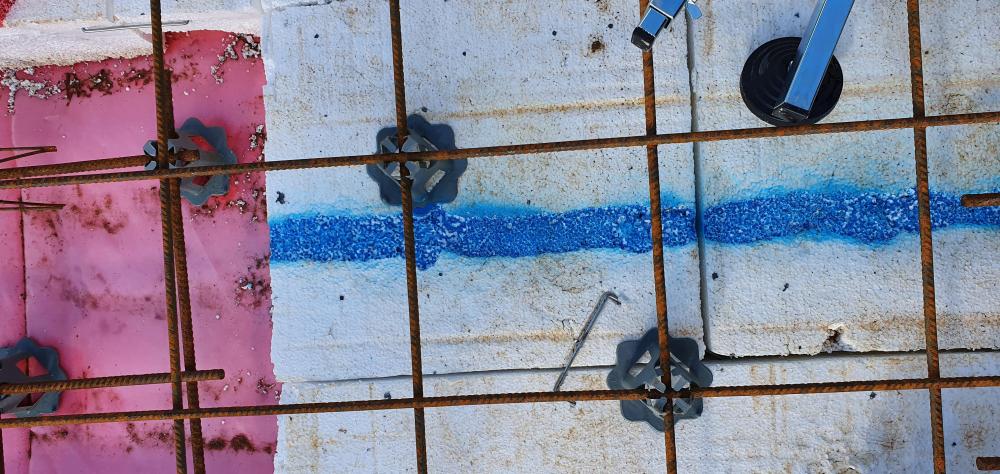Leaderboard
Popular Content
Showing content with the highest reputation on 03/21/20 in all areas
-
Following the screw pile install this week we had the steel framework installed. Lovely job. Only 1 issue where 1 beam which is below current ground level was blocked by a large concrete slab that we didn't expect - solution was to fit it about 50mm higher than the rest which will be fine if we cover in concrete. Now that's in, we can order the beam and block. Just waiting on SE to confirm a slight change to that. So probably 2-3 weeks until the area is ready for storage etc but great progress. Even got a hornbeam installed to provide some screening for the neighbours.1 point
-
Imo you couldn't be more wrong for the reasons I've already outlined. It makes for a healthier environment all round.1 point
-
You can't really knock @DavidHughes the assessment looks pretty thorough. Think we just need to accept the argument that in most cases it will cost you more than it saves. As previously discussed it's what you get for that cost and of the benefits are worth it to you. Be an interesting thread for @Russell griffiths to follow!1 point
-
Lesson learnt - dont use spray paint on EPS, it doesn't like it!! Should have been obvious really but I was in 'let's get the floor plan sprayed out so I can do the UFH' and didn't think: Spotted it quick so had only sprayed a short line. Not sure of the best way to work out where doors are so I can route the pipes through the 'safe' areas. In the end I cut some timber lengths 900mm long and positioned them where the door openings are. If I had lots of pipes to go through an opening I then ran the fitst pipe 50mm in from the edge to give me a buffer and that pipe then acted as my marker. If only a couple of pipes went through a particular doorway i ran them through the middle. Cable tying the pipes takes forever. I now wish I had hired one of those tools that tie mesh for you and used it for both the mesh and UFH pipe, would have saved me a lot of effort. It's not 'hard' work but it ruins your knees and back. I'm 37 and fit, but I can feel the damage being done to my knees and it isn't good - I've already had some damaged cartilage removed from one when my cruciate was reconstructed. I hadn't realised how much the back and knees would be affected doing this.1 point
-
Just checked an architrave, and it was 70.19mm x 18.69mm, so slightly over on width and slightly under on thickness (for some reason I thought it was 20mm thick, but it seems it's all 19mm).1 point
-
I used solid oak skirting and architrave, all fixed with adhesive and most of it without clamping. The skirting was easy, as it just stayed in place using just Sticks Like Sh*t. The architrave was trickier, but I found that running Sticks Like Sh*t down the wall bit, then using mitrebond on the lining to architrave bit worked very well. The technique was to put both adhesives on the lining/wall bit first, then apply the mitrebond primer stuff to the architrave and carefully stick it on. You have very little time to get the position right before the mitrebond goes off, but it does mean you can just apply pressure with your hands for a few seconds and then the things are bonded. They've been on for 5 years now, with no sign of any problems (and no pin holes to fill).1 point
-
1 point
-
I am a firm believer that you do not need under floor heating in a hallway. So what I have done, is where 4 pipes have to pass through the hallway to get to the kitchen / diner, they do so through the hallway at the normal pipe spacing, and that is the only UFH pipes at all in that hall. That works very well. The other 4 pipes for the 2 loops in the living room, pass under the stud wall between the utility and the living rom, immediately behind the manifold. Like I say, sketch out your layout and throw it open to the forum for a design by committee1 point
-
The only real choke point on our UFH is where all the pipes have to go through one doorway from the utility room to the kitchen. Doorways closest to the manifold will inevitably have to accommodate a closer spacing, but there's no real reason to run tight groups of pipes around a room like that I'd have thought.1 point
-
No you can set up an account for free. If you paid for a Prime account you do get access to a lot of TV and Music as well as reduced delivery costs for a pretty low price per year.1 point
-
I think that on our drawings they said they would insulate it in areas where they had lots of pipes together. The things I have noticed are - 1. Make sure the manifold is well hidden, they are pretty deep from the walls and the UFH people will just stick it somewhere which may not be where you would feel it was best hidden. 2. The manifold gets warm and puts out heat, you can save a bit on heating if you put it somewhere in a room that will need heated more. Most of ours are in spare rooms, if it was in the wardrobe in an occupied bedroom it would pretty much heat that room. 3. On the other hand of course don't put the manifold somewhere likely to get too hot as you cannot turn it off. Hot water can circulate to the manifold when it is not in use and when only one circuit runs the whole thing gets hot and warms up whatever room it is in. 4. Manifolds contain a lot of moving parts and something will break eventually so make sure you can get at it for maintenance.1 point
-
1 point
-
No the sure on the others but with quooker you can purchase an additional scale control unit. Given the cost of the tap I think it's worth the extra couple of hundred quid, I've just brought a quooker and opted for one myself!1 point
-
Don't get the version 1 they are dead slow. Get the 4k one. When you put it in to the TV and do the startup registration bit you connect it to your WiFi and enter your Amazon account details. Then you can pick from a selection of apps just by using the up,down, left right cursor on the remote. iPlayer etc are in this bit so you just pick what you want. It will already have all the amazon apps pre installed as they want you to buy films, TV series etc but you don't have to of you don't want to. The remote is very good for navigating it's own menu but if you install a web browser it's brutal. If you have a smart phone then you can use it instead of the remote but it does the same thing.1 point
-
1 point
-
The magazine fed bog roll holder is on hold given the current "ammo" shortage...1 point
-
This is a great idea, I have searched quite a lot but it can be struggle to get all the info, hence following @LA3222s raft execution very closely to make sure I don't miss anything. @LA3222 I have to take the time to commend you, doing an absolutely brilliant job and the fact that you take the time to share it with us is mega helpful for me and others who will be doing the same. Really helps demystify the process and gives a confidence boost to me that it can be done. Well done to you and the missus so far and thanks again.1 point
-
They come with a phosphate dosing filter to reduce the build up of limescale, or at least ours did.1 point
-
1 point
-
The main reason to buy is that you can make poached eggs as quickly as one can make toast. it’s life changing.1 point
-
At our old house we seemed to be lucky to get a kettle to last more than three or four years. Didn't seem to matter whether we bought an expensive one or a cheap one, they seemed fail after about the same length of time. Main problem is the very hard water, I think, it tends to kill kettles fairly quickly. When we lived in Cornwall, and in Scotland, kettles seemed to last pretty much forever.1 point
-
1 point
-
And less clutter. With most things being built in, we only have ONE item permanently plugged in in the kitchen, and that is the toaster. And I am really surprised there are no built in offerings for that.1 point
-
I agree, but our Itho Daalderop 3 in 1 boiling water tap wasn't massively expensive. We opted for the brushed stainless one and it cost a bit under £700 IIRC. A similar quality 2 way mixer kitchen tap would probably have cost a couple of hundred or so, so we probably paid around £400 more for the convenience of having boiling water on hand. Definitely a "nice to have" rather than an essential, but not that much more cost overall when compared with a decent kitchen tap and the cost of two or three kettles over a ten year period. In the case of our unit, the water is held at around 105°C to 108°C in the reservoir and when dispensed is actively boiling as it comes out of the tap, so very close to 100°C, and will sometimes continue boiling in the cup if that's already warm. I may measure it later, just to be sure, but I'd be surprised if it drops to as low as 90°C until some time after it's been sat in the cup. It looks very much as if the water coming out of the nozzle is still slightly superheated to me, as there is definitely a risk of scalding from the spitting as the pressure drops as it comes out and the water flash boils as a consequence. You soon learn that there is a definite technique to using it, if you don't want to get splashed with boiling water.1 point
-
Thanks is that 20w/day? Seems very low. I suppose they used the same energy to bring fresh water to temp given physics!1 point
-
I’m too lazy to work it out, how long would it take a litre of boiling water to cool to 90 degrees? obviously surface area counts so a 2:1 height/width glass jug... could that time be manageable? If a better tap were not capable of altering the temp in this way?1 point
-
I had a call today. The plumber tried to start up the heating today but it kept tripping. when i wired it I connected it to a B32 mcb as that was all I had, but every time the compressor tried to start the mcb tripped. so I went over there this afternoon and swapped it for a C32 and all is well. The operation as I suspected is very basic. By default it has a target temperature of 55 degrees for the buffer tank and it runs the HP continuously until that is reached. It then turns off until the buffer tank temperature drops to 50 degrees when it re starts. The highest running current I measured was 19 amps, which is a power input of about 4.3kW but more typically it was running at about 14 amps or 3.2kW input power.1 point
-
Hi John, only joined recently myself. Not a bad bunch, plenty of knowledge going back and forth.0 points
This leaderboard is set to London/GMT+01:00








